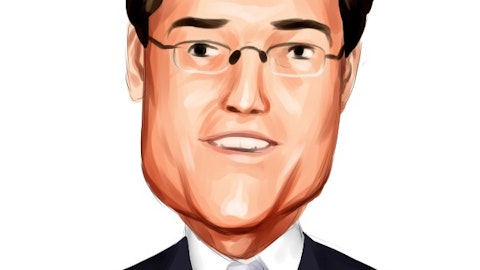Sam Sato : Yeah, not necessarily. I would just say, as we laid out in our Big Dam Blueprint, the big chunk of our investments are based on a digital-first mindset, digital-first business and really you think about, for example, our traffic and transactions coming from a mobile device are at their highest levels that they’ve ever been and we’re consistently holding to those levels and in fact continue to grow as a percentage to our total online business. So we recognize that our investments have to be about enabling a digital marketplace, so to speak. Having said that, we recognize stores are really important piece of our omni-channel customer experience and it’s about gaining and garnering new consumers. We recognize that. It’s a place to provide incredible service opportunities for the consumer, whether it’s buy online and pick-up in store or even return or exchange product.
We recognize the importance of that. Hence, we just completed a remodel in our St. Charles, Missouri store to a new format which was based on a lot of work we did with the consumer in terms of what they want and expect out of a modern customer experience journey and so we’ve done that. And so we’re going to continue to look for opportunities to open stores, but we’re going to be highly opportunistic about that given the backdrop of what we are expecting in 2023 and some of the priorities we have around technology and logistics investments, we want to be really prudent about where our capital outlays go. And again, building for the long-term value and growth benefits of the company.
Jim Duffy : Understood. Thank you, Sam and best of luck for the team through the holiday season.
Sam Sato : Appreciated. Happy holidays, Jim.
Operator: Our next question comes from Dylan Carden from William Blair. Please go ahead.
Dylan Carden : Thanks. Just a point of clarification. Did you indicate that inventories would be up mid-teens by year-end? Did I hear that right?
David Loretta : That’s right, Dylan. That’s the estimate.
Dylan Carden : And so I guess the disconnect there, the spread between kind of the implied guidance for sales or actually the actual guidance for sales would suggest potentially that the gross margin pressures kind of persist into the front half of next year, which I imagine you are not going to blip necessarily, but maybe you will help us out as far as modeling. When does freight at least turn into a tailwind, how are you thinking €“ you were asked kind of about pricing, but what’s sort of the currency of the inventory and the risk of additional promotions kind of into the front half of the year? Anything you can say around that? Thanks.
David Loretta : Yeah, absolutely, while inventories might land up mid-teens compared to last year, it would still be on par, slightly below two years ago and that’s really a function of where our inventory was last year, unfortunately, below where it needed to be. So we just €“ we’re getting back to the level that’s necessary to enter our spring/summer season. We expect, while clearance levels today are mid-single-digits, we would end up maybe high-single-digits as we look forward to the back to the end of the fourth quarter and that’s not unusual for where we end the season. So we don’t see that the margin pressure will be there. We do have a tailwind on freight expense in the first quarter of next year that roughly almost $4 million that that will lapse and get the benefit on the gross profit margin for, but product margins will probably still be tougher than they were last year, but not due to an overhang of inventory, but just simply due to competitive pricing environment we are in.
So, we’re not concerned with the higher inventory levels just compared to prior year.
Dylan Carden : Awesome. Thank you, Dave. And then, kind of just curious, from an outsiders’ perspective here, it seems like the sales from the blueprint aren’t necessarily materializing, but the costs are, and sort of pausing the ERP deployment is a little bit telling in that same regard. What’s the capacity here to kind of €“ it sounds like as far as the guidance in the fourth quarter pull back on some of the cost here that maybe we’re building out to billion dollars in sales or whatever the ultimate target might land. Is that something where we should see a steeper reduction in SG&A in particular, sort of next year?





